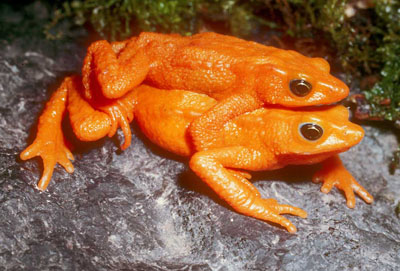Atelopus sorianoi
Class Amphibia - Amphibians » order Anura » family Bufonidae - Toads - Duméril and Bibron, 1841
Atelopus soranoi - E. La Marca, 1983
Size male: 38 - 41,5 mm.
Size female: 42 - 50 mm.

Atelopus soranoi - pair in amplexus
Geographic Range
Native to Venezuela. The distribution of Atelopus soranoi is very reduced. This species is known from a single stream in an isolated cloud forest, the Paramito de San Francisco, near the town of Guaraque, in Mérida State, Cordillera de Mérida, in Venezuela. It has the most restricted geographic range of any Venezuelan Atelopus species, and lives at an altitude of 2,400-2,718m asl.
Population
At the time of its discovery, this species was particularly abundant at the type locality. However, it is now extremely rare, or perhaps even extinct; the last record of the species was in 1990. At the time Atelopus soranoi was described it was an abundant population. In June 1988 there was more than 100 individuals observed. In 1990 was the last two known individuals of Atelopus soranoi recorded. Despite regular visits to the type locality it hasn't been possible to find A. soranoi again. All animals has been found within one single location and the area of occupancy is less than 10km²,
If you have records of Atelopus sorianoi from a later date, or photos of the species or habitat, please let us know.
Habitat
This species is known from a single location along a stream in an isolated cloud forest, the Paramito de San Francisco, near the town of Guaraque, in Mérida State, Cordillera de Mérida, in Venezuela.
Conservation
The small range of this species does not include any protected areas. Surveys are needed to establish whether or not this species still survives, and a project aimed at evaluating their population status and at assessing environmental and climate conditions of the cloud forests of Mérida State in the Venezuelan Andes (where populations of this toad might occur in remote ridges and valleys) has been initiated. Ex-situ conservation action might also be required, but for being able to do this it's needed to find surviving individuals of the species.
Threats
Infection with Batrachochytrium dendrobatidis in this species was reported by Lampo et al. (2006). Local climate data indicate that one of the most severe dry seasons recorded in the region since 1970 coincided with epidemic events. In addition, clear cutting has greatly reduced the amount of available habitat for this species.
Status
Atelopus sorianoi is critically endangered and very possibly extinct.
Sources, references, more information & links
La Marca, E. 1983. A new frog of the genus Atelopus (Anura: Bufonidae) from a Venezuelan cloud forest. Milwaukee Public Museum Contributions in Biology and Geology: 1-12.
Enrique La Marca (1995) - Atelopus soranoi - PDF Available
La Marca, E. 1995. Venezuelan harlequin frogs: in the face of extinction? Reptilian Magazine 3(8):22-24 - PDF Available
Monitoring of declines in Venezuelan Atelopus, E. La Marca, S. Lötters, 1997 - PDF Available
Catastrophic Population Declines and Extinctions in Neotropical Harlequin Frogs (Bufonidae: Atelopus) - PDF Available
Enrique La Marca, Argelia Rodríguez, Juan Elías García-Pérez 2010. Atelopus sorianoi. The IUCN Red List of Threatened Species. Version 2015.2. <www.iucnredlist.org>.
